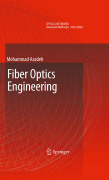
The book covers the area of fiber optics from an engineering perspective. Emphasis is placed on data conversion between electrical and optical domains and the way limitations in each domain affect the other domain. Techniques to improve the fidelity of this conversion (both from electrical to optical domain, and vise versa) are also covered. The first few chapters cover the required theoretical background including fundamentals of fiber optics communication, fiber optics networks, converting the electrical data to light, light transmissionin the medium of fiber as well as converting light back to electrical signal.A critical chapter is dedicated to characterization of optical signals. The following chapters use the theoretical background to address the design of fiber optic transceivers. The author emphasizes issues that fiber optic engineers should be familiar with, but are rarely discussed in books because they belongto an area which is neither purely electrical nor optical. Provides an interdisciplinary approach to fiber optics Emphasizes engineering and design perspectives, including insights from many years of design experience in the field offiber optics Includes simple pseudo-codes for simulation of electronic or optical circuits Covers PON and FTTX (burst mode transceivers) which are relevantto the fast growing field of fiber-to-home INDICE: Fiber Optic Communications: A Review.- Communication Networks.- Signal Characterization and Representation.- Semiconductor Lasers.- Optical Fibers.- PIN and APD Detectors.- Light Coupling and Passive Optical Devices.- Optical Transmitter Design.- Optical Receiver Design.- Reliability.- Test and Measurement.- Standards.
- ISBN: 978-1-4419-0303-7
- Editorial: Springer
- Encuadernacion: Cartoné
- Páginas: 370
- Fecha Publicación: 01/10/2009
- Nº Volúmenes: 1
- Idioma: Inglés
